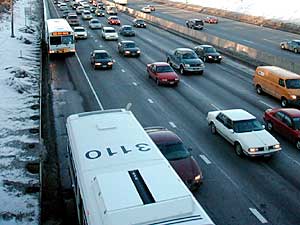|
Photos
More from MPR
Resources
Your Voice
|
Money targeted for a speedier bus ride in metro
April 14, 2004
 |
| Shoulder bus lanes, a major bus rapid transit feature, have been used in the Twin Cities for 11 years. (MPR photo/Dan Olson) |
St. Paul, Minn. — Part of the confusion over the Twin Cities transit picture may be due to timing. The proposed Metro Transit budget cuts are a response to the state's immediate revenue problems.
The bonding proposals for bus rapid transit are for two projects still on the drawing board and years away from completion.
Advocates, most of them from southern and northwestern Twin Cities suburbs are touting the Northwest transit corridor from downtown Minneapolis to Rogers, and the Cedar Ave. corridor from the Mall of America to Apple Valley.
In both cases buses would get special treatment.
Metro Transit consultant Tom Johnson says at stop lights, buses stop later and start earlier than other vehicles.
 | |||
"Buses pulling up to the signal will have a longer green time to get through the intersection, and the vehicles north south will have a longer red time," Johnson says.
More efficient fare collection is another feature of bus rapid transit.
Instead of passengers boarding buses and spending time finding pass cards, transfers or the right change as the bus waits, Metro Transit spokeswoman Molly Grove says riders will pay before they board.
"Customers will purchase their ticket at the station through a machine so they'll be able to board through both doors of a bus, so that will speed up travel time immensely," she says.
Another bus rapid transit feature has been in place on Twin Cities freeways for more than a decade and will be a part of the two transit corridors. When traffic is backed up, buses can swing out and use the shoulder as a lane.
Max Donath, who directs the Center for Transportation Studies at the University of Minnesota, says the shoulder privilege has two effects. Buses keep moving when other vehicles are crawling. And, Donath says, surveys show the bus riders believe they are making incredible time.
|
When you are on that bus and moving, and you see everybody stopped, you believe you are traveling twice as fast as you are.
- Max Donath, Center for Transportation Studies at the U of M |
"When you are on that bus and moving, and you see everybody stopped, you believe you are traveling twice as fast as you are," Donath says.
All these features -- signal preference at intersections, faster fare payment and buses on shoulders -- make bus rapid transit an attractive alternative to riders and elected officials.
The attraction for office holders boils down to money. Bus rapid transit is cheaper than rail.
The 11.6-mile-long Hiawatha Avenue light rail line will cost about $715 million.
Dakota County commissioner Will Branning says the 16-mile-long Cedar Avenue bus rapid transit corridor will be 1/3 to 1/4 the cost.
"The separate busway on this 16 miles is projected to be somewhere upwards of $190 million dollars," he says. "A shoulder run all the way 16 miles with semaphores and transit stations and what not would be around $120 million dollars."
For the Twin Cities the big question is how to pay for BRT and all the items on the ever-growing transportation wish list.
The $30 million in bonding for the Cedar and Northwest corridors has the backing of the governor and lawmakers and will likely be approved. There's no proposal so far for operating funds for the two busways since they haven't been built.
However, the bonding approved so far is but a fraction of the total cost of both projects.
Advocates for both transit corridors will be back at the legislature soon asking for tens of millions more in bonding authority to complete the busways. This as lawmakers, in an effort to deal with the state's recurring revenue problems, propose cuts in the current operating budget for Metro Transit.
Dakota County Commissioner Will Branning says the region's transportation needs are piling up.
"Unless we can move forward with transit and with Cedar Avenue, I don't know where we go. The road is full for cars, the road is full and the park and ride lots are full for bus passengers," he says.
Bus rapid transit service on the Northwest corridor is still 4 years off. Officials predict service on the Cedar avenue corridor is at least a decade away.
|
News Headlines
|
Related Subjects
|
